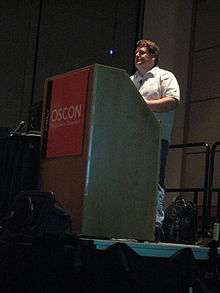Roy Fielding
| Roy Fielding PhD | |
|---|---|
 Roy Fielding speaking at OSCON08 | |
| Born |
Roy Thomas Fielding 1965 Laguna Beach, California |
| Alma mater | University of California, Irvine |
| Known for | REST, Apache HTTP Server |
| Scientific career | |
| Fields | Computer science |
| Thesis | 'Architectural Styles and the Design of Network-based Software Architectures' (2000) |
| Website |
roy |
Roy Thomas Fielding (born 1965) is an American computer scientist, one of the principal authors of the HTTP specification and the originator of the Representational State Transfer (REST) architectural style. He is an authority on computer network architecture, and co-founder of the Apache HTTP Server project.[1][2]
Fielding works as a Senior Principal Scientist at Adobe Systems in San Jose, California.[3]
Biography
In 1965, Fielding was born in Laguna Beach, California. He describes himself as "part Maori, Kiwi, Yank, Irish, Scottish, British, and California beach bum".[4][5][6]
In 1999, Fielding was named to the MIT Technology Review TR100 as one of the top 100 innovators in the world under the age of 35.[7]
In 2000, Fielding was granted his doctorate by the University of California, Irvine.[8]
Contributions
Architectural Styles and the Design of Network-based Software Architectures, Fielding's doctoral dissertation, describes Representational State Transfer (REST) as a key architectural principle of the World Wide Web, and received a large amount of attention. People now frequently hold up REST as an approach to developing web services,[8] as an alternative to other distributed-computing specifications such as SOAP. Fielding has also been heavily involved in the development of HTML and Uniform Resource Identifiers. Fielding was a co-founder of the Apache HTTP Server project[9][10] and was a member of the interim OpenSolaris Boards until he resigned from the community in 2008.[11] He was the chair of the Apache Software Foundation for its first three years and was a member of its board of directors until May 2014.[12]
Between 2001 and 2006, Fielding worked on Waka, an application protocol intended as "a binary, token-based replacement for HTTP".[13] It was "designed to match the efficiency of the REST architectural style".[14][15]
References
- ↑ "Roy T. Fielding's personal Web site". 2012-11-19. Retrieved 2013-03-04.
- ↑ "Roy Fielding's publications in Google Scholar". Retrieved 2013-03-04.
- ↑ "Roy T. Fielding". LinkedIn. Retrieved 2017-08-28.
- ↑ "Roy T. Fielding: Life story". University of California, Irvine.
- ↑ Roy T. Fielding (2011-07-27). "Re: OpenOffice.org branding". www-legal-discuss.
- ↑ Roy T. Fielding (1999-07-02). "Re: Kiwi Fruit". FoRK mailing list.
- ↑ "1999 Young Innovators Under 35". Technology Review. 1999. Retrieved 2013-03-04.
- 1 2 Fielding, R. T.; Taylor, R. N. (2000). "Principled design of the modern Web architecture": 407–416. doi:10.1145/337180.337228.
- ↑ Mockus, A.; Fielding, R. T.; Herbsleb, J. (2000). "A case study of open source software development". Proceedings of the 22nd international conference on Software engineering - ICSE '00. pp. 263–272. doi:10.1145/337180.337209. ISBN 1581132069.
- ↑ Mockus, A.; Fielding, R. T.; Herbsleb, J. D. (2002). "Two case studies of open source software development: Apache and Mozilla". ACM Transactions on Software Engineering and Methodology. 11 (3): 309–346. doi:10.1145/567793.567795.
- ↑ Roy T. Fielding (2008-02-14). "Sun's Responses to the OpenSolaris Trademark Questions". ogb-discuss.
- ↑ "Apache Software Foundation Board of Directors Meeting Minutes". 2014-05-21. Retrieved 2014-07-08.
- ↑ "A conversation with Roy Fielding about HTTP, REST, WebDAV, JSR 170, and Waka". jonudell.net. 2006-08-25.
- ↑ Roy T. Fielding, Ph.D. (2002-11-19). "waka: A replacement for HTTP" (PPT).
- ↑ Fielding, Roy T. (2012). "The Waka Protocol" (PDF). IETF.org. Retrieved 2017-03-23.
Bibliography
- Fielding, Roy Thomas (2000). "Architectural Styles and the Design of Network-based Software Architectures". Dissertation. University of California, Irvine.